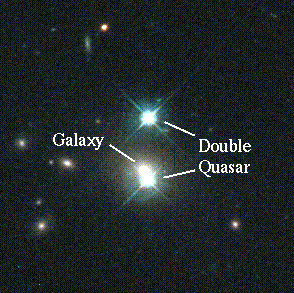-
Gravitational lensing was long predicted by Einstein's General Theory of Relativity - if gravity can be properly
viewed as a bending of space produced by mass, then light rays should change their direction upon passing a
massive object. In extreme cases, we might expect to see multiple images of the same object, formed by light that
has gone around opposite sides of the intervening mass.


The first examples of such lensing involved quasars, as the brightest objects seen at large distances. This is the first confirmed lensing case, the double quasar 0957+561. It was found while searching for counterparts of radio sources, when two candidates showed up only 6 arcseconds apart. In a 1979 paper, Dennis Walsh, Bob Carswell,and Ray Weymann showed both to be quasars with identical redshifts and spectra, which led them to speculate that this might be a gravitational lens. Shortly thereafter, observations from Mauna Kea and Palomar showed a luminous galaxy almost in front of one quasar image, and a surrounding cluster that could also contribute to the lensing.